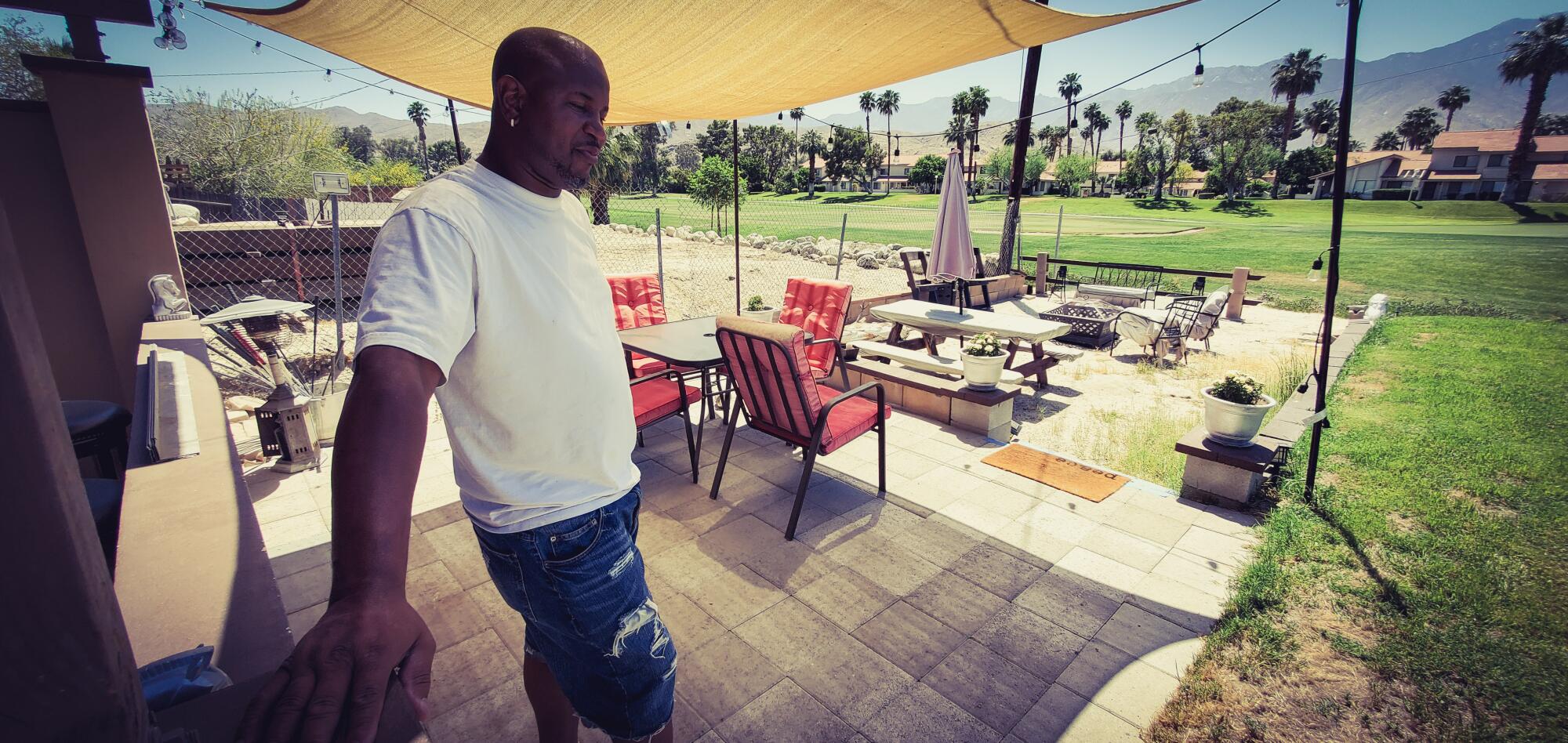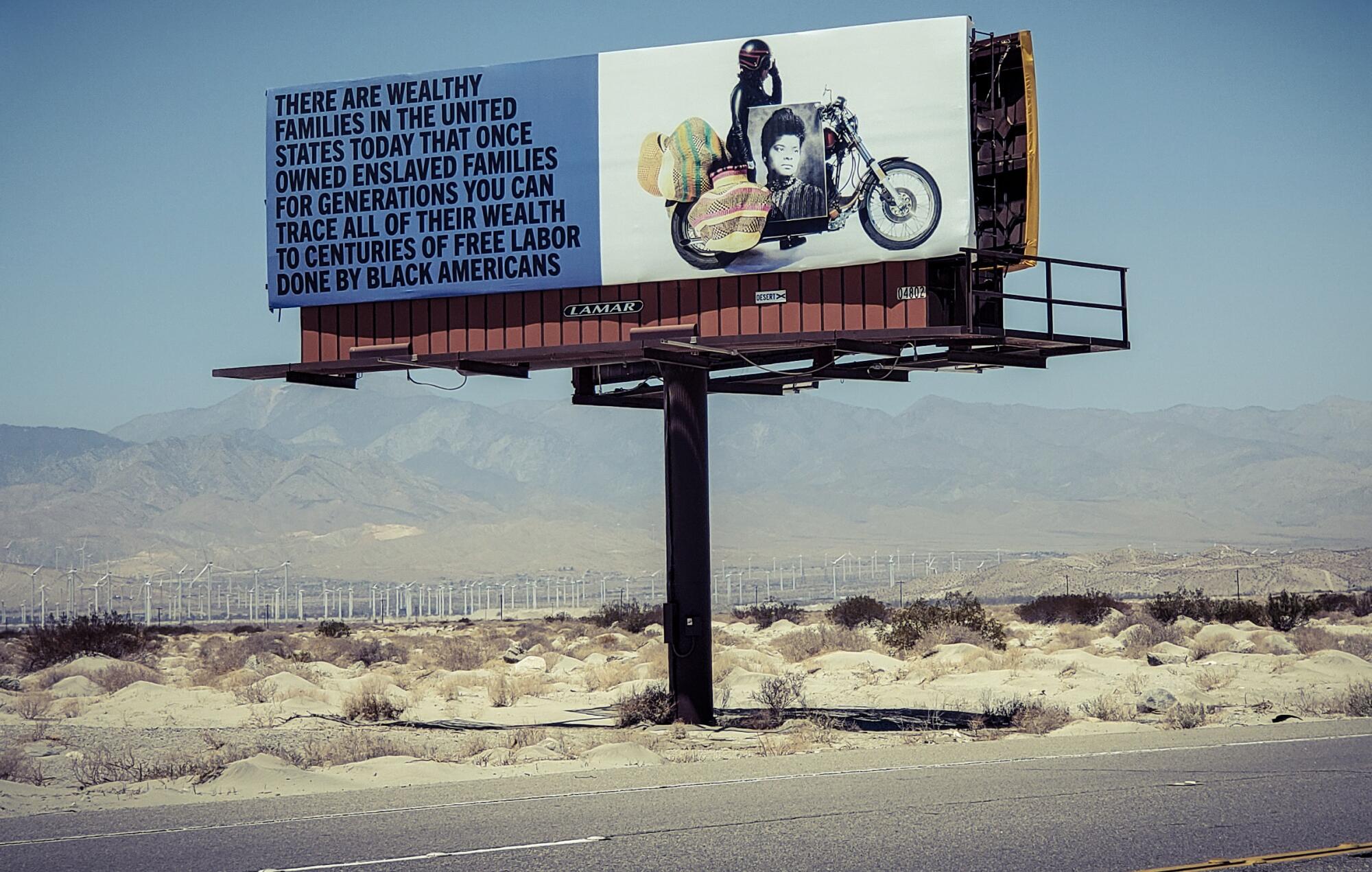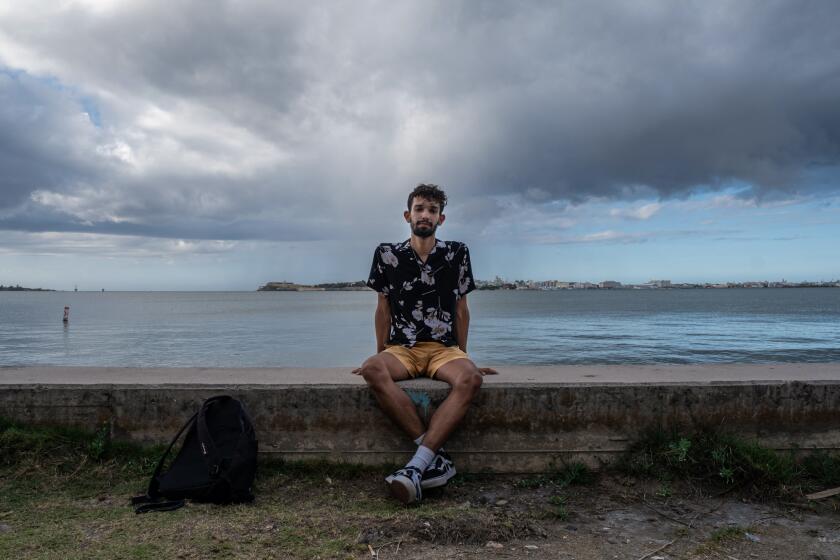
- Share via
PALM SPRINGS — La’Ronjanae Curtis has grown used to the disbelief of college classmates and friends when she tells them she was born in Palm Springs, a city of 48,000 where people of color are relatively few.
“There are Black people out there?” they always say. Curtis proudly tells them that she’s living proof.
Tourists flock to the Coachella Valley and Mojave Desert to take in the psychedelic hues of their sunsets, lose themselves among otherworldly rock formations, and sip drinks poolside at Modernist hideaways in Palm Springs the way Frank Sinatra and the rest of the Rat Pack did in an earlier era.
For the few Black Americans who live in the California desert, it takes willpower to feel at ease in these playgrounds, and imagination to make them feel like home.
In the first half of the last century, hundreds of Black people from the South, and from Los Angeles and the Bay Area, settled in desert communities like Palm Springs. They came for some of the same reasons that drew many white people: plentiful jobs, ample land to put down stakes, and the live-and-let-live openness of what still felt like America’s frontier.

But the picture-postcard settings and air of possibility masked an uglier reality for Black newcomers.
Many towns historically restricted Black families to segregated neighborhoods through housing covenants and lending practices. That legacy lives on.
Today, the presence of an established Black community isn’t obvious when driving through Curtis’ hometown, where low-lying houses hide behind Moorish-style screens, meticulously kept cactus gardens look as untouchable as jewelry displays, and locals ride around their condo complexes in golf carts designed to resemble Mercedes and Rolls Royces.
Most Black residents live far from the carefully constructed fantasy visitors see.
Curtis, who attends San Diego State University, says relatives on both sides of her family migrated from San Francisco in the middle of the last century. They mainly settled in Desert Highland Gateway Estates, a neighborhood of about 400 homes that sits on the wind-whipped northern outskirts — three miles from the Midcentury Modern furniture stores and spray-misted restaurant patios of downtown.
The other historically Black neighborhood, Lawrence Crossley, is at the opposite end of the city near the airport — a single U-shaped street lined with several dozen two- and three-bedroom houses shaded by palms. The lush green of a municipal golf course borders the neighborhood on one side. At the far end, a strip of barren desert.

“Back in those times, you had the KKK out there that was oppressing people.”
— Dominique Brenagh, on the South during the Jim Crow era
Dominique Brenagh, 38, takes shelter from the 100-degree heat in the shade of his carport at the small ranch-style house where he grew up and his family still lives.
Brenagh says his father’s relatives moved to Palm Springs in the 1950s from Louisiana in part to escape the segregation and violence of the Jim Crow era.

“Back in those times, you had the KKK out there that was oppressing people,” he says of the South.
Brenagh looks back on his own life as a happy one by comparison. He smiles when reminiscing about sneaking from his backyard onto the golf course to play with friends.
“I love it here,” he says.
Just then, his father, Carl Brenagh, pulls into the driveway. His recollections are more measured.
The elder Brenagh says that while he made a decent living as a city employee for 36 years, and got along with most everyone, he understood that Black people were not particularly welcome in Palm Springs.
As a Black man in America, I’ve always struggled to embrace a country that promotes the ideals of justice and equality but never fully owns up to its dark history of bigotry, inequality and injustice.
Now, more than any time in recent history, the nation seems divided over this enduring contradiction as we confront the distance between aspiration and reality. Join me as I explore the things that bind us, make sense of the things that tear us apart and search for signs of healing. This is part of an ongoing series we’re calling “My Country.”
He once got into a fistfight with a white man who had repeatedly called his children the N-word while chasing them off the golf course.
“It was a good life” in Palms Springs, says Carl, 74. “But it wasn’t always fair.”
A group of neighbors recently persuaded the city to cut down a row of invasive tamarisk trees bordering the golf course, planted in the late 1950s as Black families began to settle in Lawrence Crossley. The trees stood as high as utility poles, obscuring the city’s signature geological landmark — 10,800-foot San Jacinto Mountain.
Homeowners believed the trees were planted with racist intent, isolating them physically and hurting them financially by denying them the higher property values that come with living next to a golf course.
Christopher Williams, 44, a lifelong resident who helped lead the tree-removal effort, had joined Brenagh on some of those childhood golf course escapades. His grandparents had relocated to Palm Springs from the South, too.
While giving a tour of his backyard a few doors down, Williams, who works for a shipping company, looks out at the peak that for decades was blocked from view.
“This is about preserving a legacy,” he says of his decision to buy a house in the neighborhood where his parents — and their parents — owned homes.
“I’ll never live anywhere else.”
::
A sign in Williams’ backyard reads: “Be rooted and stand tall.”
But another message, written on a commemorative park bench at the community center across town in Desert Highland Gateway Estates, suggests how difficult it has been for Black residents to live by those words.

“The neighborhood was born after city officials began forcing blacks and others out of downtown,” the quote reads.
The line refers to Section 14, a working-class neighborhood of homesteads and shacks that once sat on land owned by the Agua Caliente Band of Cahuilla Indians in the city center. It was home to many Black people, Mexicans and Native Americans until the 1960s, when local officials orchestrated the forced removal of residents and razed their houses as part of a redevelopment plan.
The city’s convention center and a casino now occupy much of the land.
Some families relocated to Lawrence Crossley, which is named after the Black landowner who’d set aside parcels for Black people looking to put down new roots there.

Jarvis Crawford, the community center’s manager, says his grandparents were among the dozens of Section 14 homeowners who chose to resettle on the north side of town. They turned the area into a cultural hub, establishing three churches.
Growing up, Crawford, 45, learned from his elders about the humiliation of being forced to enter restaurants in Palm Springs through the back door because they were Black, having to travel more than 30 miles to get bank loans, and being relegated to housekeeping, restaurant and construction jobs.
“Part of me is angry, because look what my family went through,” says Crawford, who now lives 20 minutes away in Desert Hot Springs. “But another part of me feels appreciative because they were able to withstand it and move forward.”
Curtis has mixed feelings, too.
While watching her 8-year-old sister play on the community center’s lawn one afternoon, the 22-year-old says it’s sad to see the Black population in this neighborhood decline from 100% in its heyday to about 50% today.
Puerto Rican Kemuel Delgado hates having ‘one foot in and one foot out’ of America. But race wasn’t on his mind when he began pushing for statehood.
Widespread poverty and joblessness have prevented many from holding onto houses their families worked so hard to build in the face of so much racism.
“I just wish my people had the resources and the knowledge to keep this community Black,” Curtis says.
::
Is there anywhere in America that Black people can go where we never have to worry about being uprooted or pushed aside because of the color of our skin — anyplace where we can finally let our minds rest?
This question rings in my head as I travel an hour northeast of Palm Springs and spend the next few days crisscrossing the Mojave Desert, driving along lonely country roads that disappear at the horizon and down streets paved with sand.
- Share via
Times staff writer Tyrone Beason tours the Noah Purifoy Outdoor Desert Art Museum in Joshua Tree and explores how the exhibit of the late L.A. artist’s works could be a place of reflection and healing for Black Americans.
The elevation climbs above 2,500 feet and the temperature drops by 10 degrees. Meadows of purple cactus burst with yellow blossoms, and the twisted branches and spiky leaves of Joshua trees conjure images of revelers raising their hands to the sky.
It was at the Noah Purifoy Desert Art Museum of Assemblage Art, located on an unpaved road in the town of Joshua Tree near the national park of the same name, that I first saw how the desert could serve as a place of reflection, purging and healing for Black Americans.
Purifoy, who died in 2004 at the age of 86, gained fame in the aftermath of the 1965 Watts uprising by scavenging charred relics from burned buildings and assembling them into works of art.
He never wanted to be known as an activist. But as a native of Alabama who grew up in the Jim Crow era himself, he understood that chronicling injustice through art can help the viewer come to grips with the rage and suffering it causes.
They hit the streets almost as soon as the fires had died down.
At first glance, the museum looks like a salvage yard with its smattering of old tires, bathroom fixtures, dated TVs, ragged clothes, toys and vacuum cleaners. But each piece seems to tell a story.
A wooden panel has a water fountain and a toilet fastened to it. Above the fountain a wooden board reads “White.” Above the toilet, a second board reads “Colored.”

Freestanding walls and crumbling foundations seem to reference burned, bulldozed and abandoned homes.
Another wooden structure looks like three adjoining voting booths on one side, with the pants and shoes of three people visible at the bottom.
As I walk up to a patch of sand decorated with little white crosses, not far from a wooden platform that brings to mind a gallows, scenes of bombings and lynchings come to mind, dredging up a bitterness so deep I have to step away.
Twenty minutes east of the museum, in Twentynine Palms, Karen Harper and Carrie Williams share how they’ve dealt with the racism they’ve experienced while living in the desert for the last three decades.
New York natives who settled here in the late 1980s and ’90s while working at the town’s military base, the sisters now sell hair products for Black and brown women at their shop, Jeanine Beauty Supply.

Harper, 57, spent much of last summer waving signs for racial justice to bring the nationwide George Floyd protests to this largely white and conservative pocket of California. Williams, 62, often joined in.
Some motorists gave them the middle finger during the demonstrations. Others yelled, “Get out of here!” as they waved Trump flags.
Black Americans “can get along with anybody,” Harper says. “But people can’t get along with us.”
Even with the racial tension and social isolation, living a few minutes from Joshua Tree National Park has given the sisters something precious.
The immigration debate poses a moral dilemma for America.
“I can just drive to the park knowing that I’ll have peace there, that nobody can bother me,” Harper says.
Williams took up rock climbing, pushing herself to brave the terrifying heights.
“The more I cheer myself on, the higher I go,” she says with a yelp.
Purifoy described his repurposing of found objects as “a concept that, by taking junk and making it into something else, can help make people realize that their junk — their lives — can be shaped into something worthwhile.”
We as Black Americans have found different ways to figuratively shatter racism into so many pieces of scrap, so as not to let centuries of injustice extinguish our love of life.

The Black residents of Palm Springs built lasting communities on that city’s dunes.
Purifoy crafted his crowning artwork in a field of Joshua trees.
Williams reassures herself while scaling boulders by declaring, “I am the rock!”
I drive into Joshua Tree National Park just before the sun dips below rock formations that were sacred before any Black or white person knew they existed.
Something Harper said comes back to me: “It’s sad to have to say it, but Black people, we’re here to stay.”
We are here to stay.
Drawing strength from these words, I stroll among the trees that give the park its name and let the fresh desert air fill my lungs.
The sky turns from blue to orange to dusky violet. And that’s when I hear what I’ve been longing for, a glorious noise. Silence.
More to Read
Get the L.A. Times Politics newsletter
Deeply reported insights into legislation, politics and policy from Sacramento, Washington and beyond. In your inbox twice per week.
You may occasionally receive promotional content from the Los Angeles Times.















